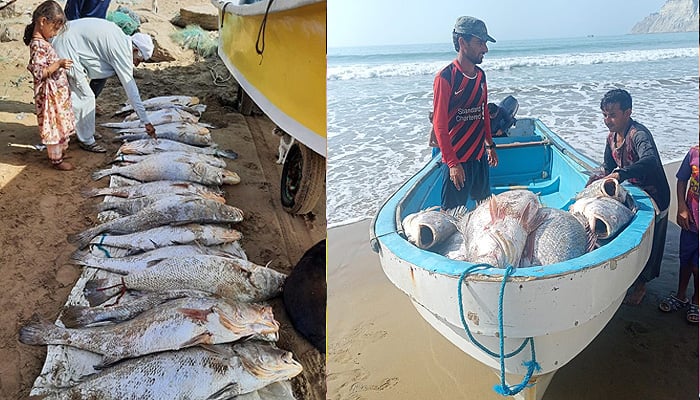Fisherman catches 18 high-prized large croakers at Gunz, Balochistan
The main reason for such high prices is the large swim bladder, commonly known as fish maws, which these species have for buoyancy and communication.
KARACHI: A fishing boat operating in the offshore waters of Daran, Jiwani caught 18 large croakers (called Kir in Balochi) worth millions of rupees and landed at Gunz in Jiwani, Balochistan on May 15, 2022. The largest specimen among this lot fetched Rs. 500,000, whereas the smaller fish may get around Rs. 100,000.
Sajad Umer, the Nakhuda (captain) was jubilant at this catch, which was made through bottom-set gillnets and fetched a total of about Rs800,000 in a one-day expedition.
Spotted croakers and Japanese meagre are two species of large croakers found in Pakistan and have fetched very high prices to the tune of millions of rupees in the recent past. The main reason for such high prices is the large swim bladder, commonly known as fish maws, which these species have for buoyancy and communication.
This is used in making soups thought to ease pregnancy-related discomfort and cure joint pain, among other ailments, and as speculative investments. A single swim bladder could fetch as much as Rs. 50,00,000 per kg in Hong Kong or Guangzhou market.
In Pakistan, the large croaker used to be harvested for decades because of the high quality of its meat. The export of its swim bladder from Pakistan started about 170 years back when dried fish maws (also called isinglass) used to be exported to Europe for clarification of wine and beer.
However, due to the high prices offered in the Chinese market and the availability of alternates for clarification, dried fish maws now end up only in the Chinese market.
According to Muhammad Moazzam Khan, Technical Advisor, WWF-Pakistan, the large croakers are local migrants and form large spawning aggregations, locally known as “Aáranga” in Balochistan and “Pinn” in Sindh. He said that these aggregations were frequently observed in coastal waters off Jiwani, Gwadar, Ormara, Sonmiani Bay and off Indus Delta about 20 years back, however, now such aggregations are rarely observed in Pakistani waters.
Increased demand of fish maws in the Chinese markets has depleted the stocks of the large croaker globally and some species, such as yellow croakers in China and totoaba from Baja California are already depleted. Khan warned that the threat of depletion of the spotted croaker (Protonibea diacanthus) and Japanese meagre (Argyrosomus japonicas), inhabiting the waters of India, Pakistan and the Persian Gulf, is increasing and unless adequate measures are taken, it is feared that large croakers may become locally extinct.
Sudheer Ahmed, Research Associate at WWF-Pakistan’s Information Centre at Jiwani informed that the occurrence of spawning aggregations is frequently reported from the Daran-Jiwani area since the last four years. Fishermen caught a number of large croakers from the area in 2019 and 2020.
-
 Jelly Roll Reveals How Weight Loss Changed Him As A Dad: 'Whole Different Human'
Jelly Roll Reveals How Weight Loss Changed Him As A Dad: 'Whole Different Human' -
 Prince Harry Gets Emotional During Trial: Here's Why
Prince Harry Gets Emotional During Trial: Here's Why -
 Queen Camilla Supports Charity's Work On Cancer With Latest Visit
Queen Camilla Supports Charity's Work On Cancer With Latest Visit -
 Dove Cameron Opens Up About Her Latest Gig Alongside Avan Jogia
Dove Cameron Opens Up About Her Latest Gig Alongside Avan Jogia -
 Petition Against Blake Lively PGA Letter Gains Traction After Texts With Taylor Swift Revealed
Petition Against Blake Lively PGA Letter Gains Traction After Texts With Taylor Swift Revealed -
 Netflix Revises Warner Bros. Deal To $83 Billion: All-cash Offer
Netflix Revises Warner Bros. Deal To $83 Billion: All-cash Offer -
 Prince Harry Mentions Ex-girlfriend Chelsy Davy In UK Court
Prince Harry Mentions Ex-girlfriend Chelsy Davy In UK Court -
 David, Victoria Beckham 'quietly' Consulting Advisers After Brooklyn Remarks: 'Weighing Every Move'
David, Victoria Beckham 'quietly' Consulting Advisers After Brooklyn Remarks: 'Weighing Every Move' -
 Meta's New AI Team Delivered First Key Models
Meta's New AI Team Delivered First Key Models -
 Prince Harry Defends Friends In London Court
Prince Harry Defends Friends In London Court -
 AI May Replace Researchers Before Engineers Or Sales
AI May Replace Researchers Before Engineers Or Sales -
 Christina Haack Goes On Romantic Getaway: See With Whom
Christina Haack Goes On Romantic Getaway: See With Whom -
 Consumers Spend More On AI And Utility Apps Than Mobile Games: Report
Consumers Spend More On AI And Utility Apps Than Mobile Games: Report -
 Aircraft Tragedy: Missing Tourist Helicopter Found Near Japan Volcano Crater
Aircraft Tragedy: Missing Tourist Helicopter Found Near Japan Volcano Crater -
 Taylor Swift Lands In Trouble After Blake Lively Texts Unsealed
Taylor Swift Lands In Trouble After Blake Lively Texts Unsealed -
 'Prince Harry Sees A Lot Of Himself In Brooklyn Beckham'
'Prince Harry Sees A Lot Of Himself In Brooklyn Beckham'




